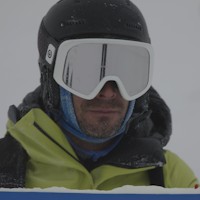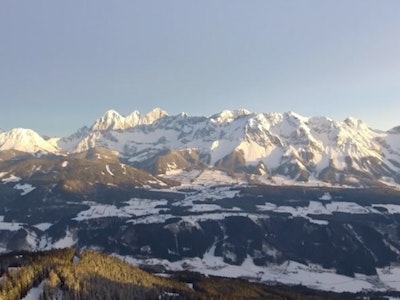Year-in and year-out, multiple production companies and athletes pour their blood, sweat and tears into making meaningful and original skiing content. Countless industry professionals and up-and-comers alike utilize every last bit of power and energy with the purpose of capturing the best, most unique shots imaginable. While Level 1’s 2014 film less portrays the simplicity, basics and fun that skiing is all about, the process of creating the flick was no easy feat. For our enjoyment, Level 1 and up-and-comer Khai Krepela have provided us with one of the sickest shots of the year—along with a story giving insight into hard work required to create a banger segment. Enjoy the short flick and words, provided by Mr. Josh Berman himself.
Berman says:
It took about 20 tries over two days to get the shot, though we still didn’t get it exactly how we wanted it—it just got to the point where we ran out of light, and that was the best overall combination of good light and Khai almost getting the tricks how he wanted them.
There were a few takes from the first day where the light was really incredible—we nailed shots in the last few minutes before the sun dipped over the horizon, and everything was silhouetted with streaks of pink and purple light through the trees, with gorgeous lens flare. Unfortunately, Khai really wanted a line that linked more technical tricks, so we ended up throwing out everything from day one and starting over the next evening.


It was a complete scramble both days, since we spent the majority of the our time focusing on the 100+ foot chairlift gap. As soon as the sessions wound down and we lost light on that feature, we’d rally the entire crew to the top of the mountain to get after the jib line. There wasn’t much time for practice or warmup—I think both sessions on the line were each less than one hour from the time they started until the sun went down.
With five features in a row, quickly fading light, and such an intense tracking shot there are so many variables that went into getting it just right, and we still didn’t quite pull it off. Of all the shots we logged, the one we used in the film was the only one where the camera lens got sprayed with snow on the in-run. There were a few others with much better light, and a clean lens, but Khai didn’t quite get the tricks exactly how he wanted them, so in the end we deferred to the shot that had the best action. Khai left that decision up to us, and while it pains me to use a shot with water spots on the lens, ultimately it was important to us to showcase the best combination of tricks that Khai put together and let the rest of the shot speak for itself, and hopefully distract enough from the water spots to make them excusable.


We had just gotten a MOVI and a R.E.D. EPIC a few weeks before the Schweitzer shoot—so this was really one of the first big tests we put that equipment through, and it was probably as intense a trial run as anyone has put such a rig through, learning on the go about how the system worked and what it was capable of.
I had proposed a line of jib features to Dan Nylund, Schweitzer’s head builder, and he took the ball and ran with it, putting together a line of five features. As soon as we showed up we knew that the only way we wanted to shoot them was with a top to bottom follow/tracking shot—the problem was that some of them were stacked up so tall, with sheered off walls, that a traditional wide angle/close up tracking shot wasn’t going to work. We had Dan push up some piles of snow parallel to the jib line so that my height above the ground level was comparable to the skiers as they hit the features. This required us, of course, to shoot with a longer lens instead of the traditional wide.
Individually, all five features were easy enough to handle, but trying to nail tech tricks on all of them in a row was no small task. In addition to Khai, Sandy Boville nailed a few lines in the clouds/fog before the sun broke out, and Shay Lee put down a couple as well, but that was pretty much it.
Since we were starting in the flats on top of the mountain there wasn’t any natural speed, so we were stuck with sled tows to get going. The only way that I could get a true start to finish tracking shot was to use the same sled tow that Khai was using, which meant holding onto the tow rope behind him with one hand (two fingers through the loop at the end of the rope, specifically) and holding the MOVI rig with the other, then whipping off the end of the rope to generate extra speed as soon as Khai let go. Of course as soon as the sun got low and the light started to get good, the entirety of my line was in the shadows and quickly turned to frozen chunder. I really had to focus on keeping the shot framed properly so most of the time I was just pointing my skis downhill and trusting that nothing was in my way—this made for a few very close calls with athletes and photogs, who were not paying attention and got a little too close. The whole operation was pretty sketchy.


As difficult as it was, going down was almost the easy part—getting back up the hill was another matter entirely. We were fighting time and light so getting laps as quickly as possible was important, and we didn’t have time to do snow cat laps or otherwise break the gear down for proper uphill transport. I’d end up grabbing the tow rope of another sled waiting at the bottom with one hand, and carrying the MOVI rig in the other hand, turning my body at an angle to keep the rig from getting blasted by the snow and ice kicked up by the sled. I had to switch arms from one round to the next, and by the end of each day most of my upper body was numb.




![[GIVEAWAY] Win a YoColorado X Coors Banquet Prize Package](https://www.datocms-assets.com/163516/1764877349-long-live-local-cooler-bag2.jpeg?w=200&h=200&fit=crop)

![[GIVEAWAY] Win a YoColorado X Coors Banquet Prize Package](https://www.datocms-assets.com/163516/1764877349-long-live-local-cooler-bag2.jpeg?auto=format&w=400&h=300&fit=crop&crop=faces,entropy)







